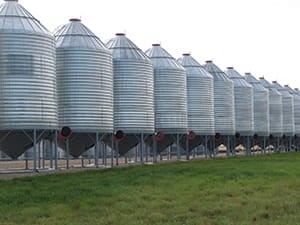REGINA — Producers were able to make significant harvest progress over the past week due to the lack of moisture.
Currently, 61 per cent of this year's crop is in the bin, up from 42 per cent reported last week. This is ahead of the five-year average of 50 per cent and the 10-year average of 46 per cent. Although the hot and dry weather has allowed harvest to progress, combine and equipment fires are a significant risk. Producers are also monitoring stored grain closely as there are concerns for bin heating given the high temperatures that occurred at the time of combining.
The southwest region is still the furthest advanced in harvest progress at 85 per cent complete. The southeast and west-central regions are past the half-way point, with 65 per cent and 54 per cent of harvest complete, respectively. The northwest region currently has 49 per cent harvested, the east-central region is 46 per cent harvested and the northeast region is 34 per cent harvested.
Harvest is nearly complete across the province for winter cereals, triticale, lentils and field peas. Durum is 83 per cent harvested, barley is 70 per cent harvested, spring wheat is 60 per cent harvested, oats are 53 per cent harvested and canary seed are 32 per cent harvested. Chickpeas are estimated to be 76 per cent harvested. For oilseed crops, mustard is the furthest advanced at 84 per cent harvested, followed by canola at 28 per cent and flax at 22 per cent harvested.
Crop yield and quality continues to vary throughout the province due to the scattered rainfall received throughout the growing season. Producers have indicated good crop quality in some areas, but there are an increasing number of producers who are concerned with light bushel weights and small seed size for various crops. Pea grades are mainly 2 CAN at 58 per cent with 39 per cent at 1 CAN; this is slightly above the 10-year average of 53 per cent 2 CAN and 39 per cent 1 CAN. Similarly, lentil grades are mainly 2 CAN at 69 per cent with 25 per cent at 1 CAN; the 10-year average is 49 per cent 2 CAN and 27 per cent 1 CAN. Durum grade quality is reported at 28 per cent 1 CW, 36 per cent 2 CW and 23 per cent 3 CW. The 10-year average for durum grade quality is 36 per cent 1 CW, 27 per cent 2 CW and 20 per cent 3 CW. Quality for barley is reported at 27 per cent malt, 48 per cent 1 CW and 25 per cent 2 CW/sample. The 10-year average for barley is reported at 29 per cent malt, 51 per cent 1 CW and 20 per cent 2 CW/sample.
There was only limited rainfall across the province this past week. The Meadow Lake area reported the highest amount of rainfall at 16 mm followed by the Yellow Creek and North Battleford areas that both reported 10 mm. The remaining areas of the province received less than 10 mm, with many receiving no rainfall to trace amounts.
Topsoil moisture conditions continue to decline in certain areas due to the hot and dry weather conditions. Currently, cropland topsoil moisture is rated as one per cent surplus, 33 per cent adequate, 43 per cent short and 23 per cent very short. Hayland is rated as one per cent surplus, 26 per cent adequate, 43 per cent short and 30 per cent very short. Pasture topsoil moisture is rated as 17 per cent adequate, 43 per cent short and 40 per cent very short. There is a significant need for large amounts of precipitation in many areas to help with replenishing topsoil and subsoil moisture levels along with improving pasture conditions.
Crop damage over the past week is mainly due to wind and migratory birds. Grasshoppers are being reported at higher numbers in some areas with overall minor to moderate crop damage estimated.
Producers are busy combining, swathing and desiccating later seeded crops, along with baling straw, hauling bales and hauling grain. Some producers are beginning their fall field work which includes harrowing and post-harvest spraying for weed control.
As harvest is a very busy time for producers, they are reminded to take safety measures in all the work they do. This includes having fire mitigation resources on hand and taking precautions when working around powerlines. The public is reminded to take extra caution, time and space when encountering machinery on the roads.

